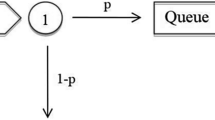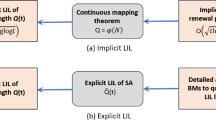Abstract
Calculation of the delay distribution of (low-priority) customers in priority queues is difficult, especially when the arrival process is correlated. In this paper, we find the generating functions of the delays of high- and low-priority customers in a discrete-time queue where the arrivals are generated by a superposition of two processes, an independent one and a correlated one that can bring an extra customer in the buffer during a slot. The latter process can be seen as a simplified model for the output process of another priority queue. As a consequence, our results can be used to estimate the delay in the second stage of a tandem queueing system with an extra exogenous arrival process. A tandem priority queue is not of product-form type and its analysis is known to be a hard problem. This paper can lead to a first approximate analysis that can later be extended to incorporate the correlation in the output process of a priority queue more accurately.







Similar content being viewed by others
Notes
Note that other orders within an arrival slot are possible which would change \(F_1^{(1)}(z)\), but the rest of the analysis would remain the same.
We have opted for mean buffer contents instead of mean packet delays for validation. With Little’s law, these can easily be transformed to mean packet delays.
References
Alfa, A., Liu, B., & He, Q. M. (2003). Discrete-time analysis of MAP/PH/1 multiclass general preemptive priority queue. Naval Research Logistics, 50, 662–682.
Chen, Z., Pappas, N., Kountouris, M., & Angelakis, V. (2018). Throughput with delay constraints in a shared access network with priorities. IEEE Transactions on Wireless Communications, 17, 5885–5899.
Choi, B. D., Choi, D. I., Lee, Y., & Sung, D. K. (1998). Priority queueing system with fixed-length packet-train arrivals. IEE Proceedings-Communications, 145, 331–336.
Grahl, J., Minner, S., & Dittmar, D. (2016). Meta-heuristics for placing strategic safety stock in multi-echelon inventory with differentiated service times. Annals of Operations Research, 242, 489–504.
Guo, S. S., Wu, D. L., Zhang, H. X., & Yuan, D. F. (2018). Resource modeling and scheduling for mobile edge computing: A service provider’s perspective. IEEE Access, 6, 35611–35623.
Gurvich, I., & Van Mieghem, J. A. (2018). Collaboration and multitasking in networks: prioritization and achievable capacity. Management Science, 64, 2390–2406.
Horvath, G. (2015). Efficient analysis of the MMAP[K]/PH[K]/1 priority queue. European Journal of Operational Research, 246, 128–139.
Hu, H., Guo, Y., Yi, P., & Chen, S. (2011). Load-balanced differentiated services support switch. IET Communications, 5, 1895–1906.
Kafaei, S., Ahmed, M. H., Chen, Y. Z., & Dobre, O. A. (2018). Performance analysis of network coding with IEEE 802.11 DCF in multi-hop wireless networks. IEEE Transactions on Mobile Computing, 17, 1148–1161.
Khalid, A., De Clercq, S., Steyaert, B., & Walraevens, J. (2016). Analysis of a two-class priority queue with correlated arrivals from another node. Lecture Notes in Computer Science, 9845, 167–178.
Khamisy, A., & Sidi, M. (1992). Discrete-time priority queues with two-state Markov modulated arrivals. Stochastic Models, 8, 337–357.
Lee, Y., Kim, Y. H., & Huh, J. D. (2003). Discrete-time \(Geo^X/G/1\) queue with non-preemptive priority. Computers and Mathematics with Applications, 46, 1625–1632.
Østerbø, O. (2005). End-to-end delay models with priority. In Proceedings of the 19th International Teletraffic Congress (ITC19) (pp. 1049–1058).
Stanford, D. (1997). Waiting and interdeparture times in priority queues with Poisson- and general-arrival streams. Operations Research, 45, 725–735.
Takahashi, Y., & Hashida, O. (1991). Delay analysis of discrete-time priority queue with structured inputs. Queueing Systems, 8, 149–164.
Takine, T. (1999). The non-preemptive priority MAP/G/1 queue. Operations Research, 47, 917–927.
van Vianen, L. A., Gabor, A. F., & van Ommeren, J.-K. (2016). Waiting times in classical priority queues via elementary lattice path counting. Queueing Systems, 84, 295–307.
Vilaplana, J., Solsona, F., Teixid’o, I., Mateo, J., Abella, F., & Rios, J. (2014). A queuing theory model for cloud computing. Journal of Supercomputing, 69, 492–507.
Walraevens, J. (2004). Discrete-time queueing models with priorities, PhD-dissertation, Ghent University.
Walraevens, J., Bruneel, H., Fiems, D., & Wittevrongel, S. (2017). Delay analysis of multiclass queues with correlated train arrivals and a hybrid priority/FIFO scheduling discipline. Applied Mathematical Modelling, 45, 823–839.
Walraevens, J., Fiems, D., Wittevrongel, S., & Bruneel, H. (2009). Calculation of output characteristics of a priority queue through a busy period analysis. European Journal of Operational Research, 198, 891–898.
Walraevens, J., Steyaert, B., & Bruneel, H. (2003). Performance analysis of a single-server ATM queue with a priority scheduling. Computers & Operations Research, 30, 1807–1829.
Walraevens, J., Wittevrongel, S., & Bruneel, H. (2007). A discrete-time priority queue with train arrivals. Stochastic Models, 23, 489–512.
Acknowledgements
The authors wish to thank two reviewers for their suggestions on how to improve presentation of the paper.
Author information
Authors and Affiliations
Corresponding author
Additional information
Publisher's Note
Springer Nature remains neutral with regard to jurisdictional claims in published maps and institutional affiliations.
Rights and permissions
About this article
Cite this article
De Clercq, S., Walraevens, J. Delay analysis of a two-class priority queue with external arrivals and correlated arrivals from another node. Ann Oper Res 293, 57–72 (2020). https://doi.org/10.1007/s10479-020-03548-1
Published:
Issue Date:
DOI: https://doi.org/10.1007/s10479-020-03548-1




